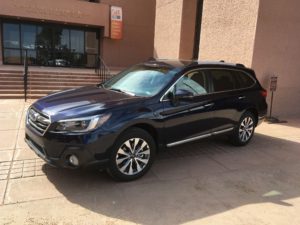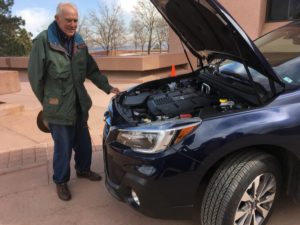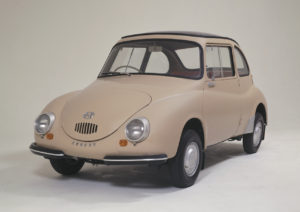
Jim Colwell and I, in the 2018 Subaru Outback Touring wagon, made the climb up to the National Center for Atmospheric Research (NCAR) above Boulder for lunch on a Wednesday morning.
Subaru this year is observing its 50th anniversary in the U.S. In the spirit of the celebration, I chose to drive the durable Outback, for more than any other model, it saved Subaru at a low point 20 years ago and led it to where it is today – seller of more than 600,000 new cars and SUVs a year in the country and second-highest brand in sales in Colorado.

I knew Jim as “Mr. Colwell” when he was my freshman English instructor at Sterling High School many years ago. Though we’ve exchanged e-mails regarding some of my auto columns in recent years, we’d not seen each other since the last day of school at SHS in late May 1952.
In addition to the drive to Boulder and NCAR, the Subaru and I made business stops in Loveland and Erie. The descent down NCAR Road in the early afternoon gave opportunity for short tests of the Outback’s 6-speed manual mode and paddle-shifting, somewhat of a departure of its continuously variable transmission, as it simulates shift points like a traditional tranny.
The CVT, in standard mode, performs smoothly tied to the Outback’s 3.6-liter, horizontally opposed (flat) 6-cylinder engine, which develops 256 horsepower. The highway driving from Greeley to Loveland to Boulder to Erie and back home resulted in fuel mileage of 25.1; the Outback’s EPA estimate is 20/27.
C-shaped headlights offer a new exterior touch for the 2018 Outback. Inside, heated front and rear seats in perforated brown leather are among highlights. The front passenger seat will power-slide fore and aft, but not up and down.
Heading the wagon’s strong safety technology is Subaru’s patented EyeSight, including cameras mounted near the top of the windshield to monitor approaching obstacles. Automatic precollision braking, adaptive cruise and lane-keeping assistance are among added safety controls of the system.
I remember the first Outback, introduced in 1995 as a variant of the Legacy wagon. With its boxer engines and sturdy all-wheel-drive structure and heavy side cladding, it endured among a rush of SUVs and more modern crossovers, and found favor with lots of outdoors persons. It caught on “big time” in Colorado, as its all-wheel drive challenged our rugged terrain and inclement weather.

Subaru of America was founded on Feb. 15, 1968 by American businessmen Malcolm Bricklin and Harvey Lamm. Its first car model was the little 360, priced at $1,290 with a 25-horsepower engine and top speed of 69 miles per hour.
For 2018, Subaru is offering each of its models with a special 50th anniversary edition, including heritage blue paint, anniversary edition badging, black interior upholstery with silver stitching and contrasting silver seatbelts.
Colwell and his wife, Claudia, are retired in Boulder following his distinguished career as an education director, ironic in the fact he dropped out of Brush High School as a 16-year-old. Born on a ranch east of Brush, he left school in 1943 and spent a year working at Hill Army Air Field in Utah before returning to Brush and finishing high school in ‘45.
He taught at Sterling after earning a journalism degree at the University of Denver in 1949 and his M.A. and lifetime teaching certificate from the University of Northern Colorado in 1951.
After two years in Sterling, he served in the U.S. Air Force in Japan and was assistant command education director in Tokyo in 1955-56. He also achieved Ph.D. and A.M. in American Studies at Yale, and studied at Heidelberg University in Germany, where he met Claudia. His career included education directorships at the University of Colorado, University of Texas of the Permian Basin, University of Maryland/European Division. He also advanced from a private rank in the U.S. Army Air Forces in the 1940s to brigadier general, USAF Reserve, in 1987.